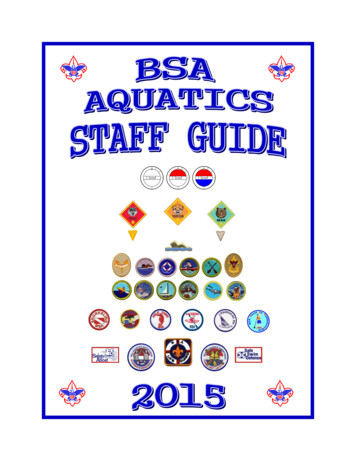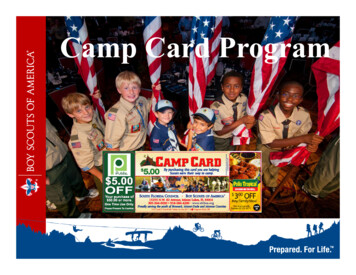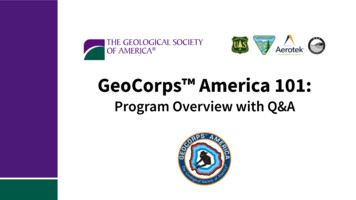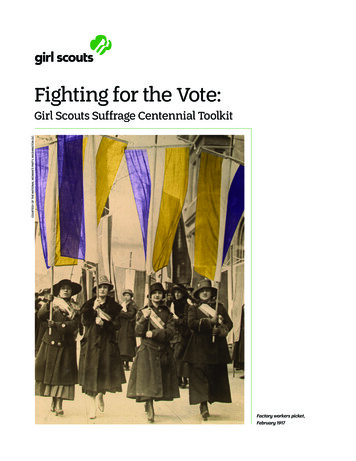
Transcription
PREFACETo the Camp Aquatics Staff Member:Welcome to the ranks of a great team! Yes, youalready belong to one of the greatest teams ever - the BSA. Now you’re part of the camp staff.You’re in for a great time, a lot of fun and a lot ofresponsibility.This guide was put together by the NationalAquatics Task Force to help you, a member of yourcamp’s aquatics staff, do your job better. Youshould work with your Aquatics Director and yourCamp Management to use this document as aguide to your development as a staff member.The intent is for this guide to be as universal aspossible -- appropriate for Cub Scout Day andResident Camps as well as Boy Scout ResidentCamps.This is a living document. The Task Force willupdate this guide annually, based on input from thefield. If there are items that you feel need to beupdated, omitted, or added please let us know.And if you have good samples or examples for theAppendix that you think other camps would benefitfrom please send in those as well. The e-mailaddress is listed below.It’s usually best to wait till the end of the season sothat input can be more objective, but if you havequestions before or during the camping seasonplease feel free to send those along as well.We have made every attempt to avoid redundancy-- information that can easily be found in otherdocuments has not been included except foremphasis.We’ve included references todocuments that you probably should haveavailable to you -- either in your personal libraryor your camp’s aquatic library. Some of theseinclude:Aquatics Supervision; A Leaders Guide toYouth Swimming and Boating Activities: BoyScouts of America; #34346; Boy Scouts ofAmerica, 2013 PrintingIf at all possible this book should be in yourpersonal library. It is all-inclusive in the area ofBSA aquatics. Even though it was written as aguide for unit leaders much of the informationincluded is appropriate for camp staff as well.Lifeguarding, 3rd ed.; American Red Cross,StayWell Publishing, #655735; rev. 2012.Lifeguarding DVD Set; #655739 – Also fromStaywellThis is the manual and DVD set you will use as atext for BSA Lifeguard. Your camp should have theDVD set available to you. The book will probablybe your responsibility to purchase.Merit Badge Series PamphletsIf you are asked to instruct a merit badge you willwant the current edition of the pamphlet for thatbadge. Again, check with your director for campcopies.Obviously, it would be impossible to includeeverything you might need to know considering thedifferent sizes of camps and the variety ofprograms offered across the country. With the helpof your director and your Camp Management adaptthis guide to your situation.Here’s hoping you have a great summer.National Aquatics Task ForceKeith Christopher, Outdoor Programs /Properties Department ManagerPat Noack, Aquatics Task Force ChairmanSteve Terrell, Aquatics Task Force Memberand Aquatics Staff Guide Coordinatoraquaticstaffguide@gmail.com
AQUATICS STAFF GUIDE – TABLE OF CONTENTSPREFACEIFEEDBACK FROM THE FIELDIIUNIT 1 -- BSA BACKGROUNDPURPOSE OF BOY SCOUTS OF AMERICABSA PROGRAM DIVISIONS1-11-1CUB SCOUTSBOY SCOUTSVARSITY SCOUTSVENTURERSPREFERRED METHOD OF SCOUT CAMPINGCAMP CATEGORIES1-2CUB DAY CAMPSCUB WEEK-END CAMPSCUB RESIDENT CAMPSBOY SCOUT RESIDENT CAMPSCOUNCIL HIGH ADVENTURE CAMPSNATIONAL HIGH ADVENTURE CAMPSPURPOSE OF SCOUTING AQUATICSYEAR-ROUND AQUATICSPUNCTUALITYCAMP TRADITIONSCLIQUESROMANTIC RELATIONSHIPSSMOKING AND TOBACCOPETSSCOUT SIGNWORKING WITH YOUTHAGE CHARACTERISTICS OF YOUTHSEVEN, EIGHT, NINE, AND TEN YEAR OLDSELEVEN, TWELVE, AND THIRTEEN YEAR OLDSFOURTEEN TO SIXTEEN YEAR OLDSWORKING WITH LEADERSBSA AQUATICS CONTINUUMAQUATICS FOUNDATIONS1-3SAFE SWIM DEFENSESAFETY AFLOAT1-3CUB SCOUT AQUATICSUNIT 2 -- STAFF ROLES AND RESPONSIBILITIES2-12-12-12-22-22-32-3UNIT 3 -- STAFF QUALIFICATIONS ANDTRAINING3-13-1AQUATICS DIRECTORASSISTANT AQUATICS DIRECTORAQUATICS PROGRAM STAFFCOUNSELOR-IN-TRAININGLEVELS OF TRAINING3-2PRE-REQUISITE TRAININGPRE-CAMP TRAININGIN-SERVICETRAININGSTAFF EVALUATIONSMERIT BADGE COUNSELORS AND INSTRUCTORSAQUATIC LEADERSHIP TRAINING COUNSELORS3-33-4BSA LIFEGUARD INSTRUCTORAQUATICS SUPERVISION INSTRUCTORBSA Swimming and Water Rescue Instructor,BSA Paddle Craft Safety InstructorSAFE SWIM DEFENSE / SAFETY AFLOAT INSTRUCTORRECOMMENDED TRAINING SCHEDULE3-5UNIT 4 -- PROFESSIONAL RELATIONSHIPSSTAFF RELATIONSHIPS AND PROTOCOLS5-15-1TIGER ELECTIVE ADVENTURE: FLOATS AND BOATSWOLF ELECTIVE ADVENTURE: SPIRIT OF THE WATERBEAR ELECTIVE ADVENTURE: SALMON RUMWEBELOS / AOL ELECTIVE ADVENTURE: AQUANAUTBOY SCOUT AQUATICSAGE REQUIREMENTSSTAFF QUALIFICATIONS AND DUTIES4-4UNIT 5 -- AQUATICS PROGRAMCOUNCIL AQUATICS COMMITTEECOUNCIL / DISTRICT AQUATICS PROGRAMSLINKS TO OTHER AQUATICS ORGANIZATIONSUNIT ACTIVITIESSTAFF EXPECTATIONSPERSONNELRECOMMENDED STAFFING LEVELSTYPICAL STAFF ORGANIZATIONuGENERALISTS VS. SPECIALISTSAUXILIARY PERSONNELEXAMPLE STAFF CHART4-24-34-15-22ND CLASS AQUATICS1ST CLASS AQUATICSAQUATICS MERIT BADGESAQUATICS AWARDSVENTURING AQUATICS5-4VENTURING AQUATICSSEA SCOUTSAQUATIC LEADERSHIP TRAINING5-4AQUATICS SUPERVISIONSWIMMING & WATER RESCUEAQUATICS SUPERVISIONPADDLECRAFT SAFETYBSA LIFEGUARDAQUATICS INSTRUCTOR BSACOUNCIL AQUATICS5-4COUNCIL AQUATICS COMMITTEESUMMER CAMP AQUATICSSUMMER CAMP AQUATICS PROGRAMADVANCEMENT PROGRAM5-5CUB SCOUT ADVANCEMENT PROGRAMElective AdventuresWebelos AquanautBOY SCOUT ADVANCEMENT PROGRAM2nd and 1st Class Rank RequirementsMerit Badge ProgramINSTRUCTION PROGRAM5-6CUB SCOUT INSTRUCTION PROGRAMNon-Swimmer InstructionBeginner InstructionSwimmer InstructionBoat Handling InstructionBOY SCOUT INSTRUCTION PROGRAMNon-Swimmer InstructionBeginner InstructionSwimmer InstructionBoat Handling InstructionTroop SwimDRESSDEMEANORAquatics Staff Guide -- TABLE OF CONTENTSi
RECREATION PROGRAM5-7CUB SCOUT RECREATION PROGRAMTheme Camp ActivitiesAcademic and Sports ProgramOpen SwimOpen BoatingBOY SCOUT RECREATION PROGRAMOpen SwimOpen BoatingAquatic AwardsMile SwimKayaking BSASnorkeling BSABoardsailing BSAScuba BSASPECIAL EVENTS AND ACTIVITIESWater CarnivalsSpecial Aquatics Facilities and EquipmentVENTURE / OLDER SCOUT RECREATION PROGRAMLocal Council Aquatics CampsHIGH ADVENTURE AQUATICSOutpost Canoe Camping50 Miler AwardAQUATICS LEADERSHIP TRAININGBOATING PROCEDURESUNIT 7 -- HEALTH AND SAFETYPHYSICAL EXAMINATIONSSWIMMING PERIODSTHE SUNSET RULE FIRST AID PROCEDURESUNIVERSAL PRECAUTIONSDIVING INJURYGENERAL HEALTH ANDSAFETY -- STAFF AND CAMPERS5-106-16-16-2DUTY TO ACTSTANDARD OF ION6-36-46-5CUB SCOUT ADJUSTMENTS TO SAFE SWIM DEFENSESAFETY AFLOAT6-6CUB SCOUT ADJUSTMENTS TO SAFETY AFLOATAQUATICS SAFETY6-8CHECK-IN PROCEDURESTHE BUDDY TAGLOST BUDDY TAGSGATE OPERATIONCHECK-IN SWIMMINGCHECK-IN BOATINGTHE “ODD” SCOUTBUDDY CHECKSSWIM CLASSIFICATION TESTSREGISTRATIONMEDICAL RECHECKCAMP TOURAquatics Staff Guide -- TABLE OF CONTENTS8-18-18-18-2PRE-ASSESSMENTMERIT BADGE AND RANK REQUIREMENTSSKILL BREAKDOWNBEHAVIOR CHANGE8-3KISMIFSTEPS IN AQUATICS INSTRUCTION“EDGE”AGE GROUPSCharacteristics of Cub Scouts and Webelos ScoutsSKILL GROUPSCOACH / PUPIL METHODPLANNINGCLASS ORGANIZATION8-8LEVELS OF LEARNINGWRITTEN REQUIREMENTSWRITTEN ASSIGNMENTS OR EXAMSUNIT 9 -- LIFEGUARDING AND SUPERVISION6-10SWIMMER TESTADMINISTERING SWIM TESTSPRE-CAMP SWIM CHECKSWEATHER PROCEDUREOPENING DAY PROCEDURESINTRODUCTIONTEACHING VS. LEARNINGELEMENTS OF TEACHINGLEARNING OBJECTIVESEVALUATION / ASSESSMENT6-7GUARD THE INSTRUCTORGENERAL OPERATING PROCEDURES7-3INFECTIONFOOT CARENOSEBLEEDSSUN PROTECTIONHYPERVENTILATIONCOLD WATERHYPOTHERMIAHEAT REACTIONSPROTECTION FROM INSECTSSUBMERSION INCIDENTSRESTTEACHING METHODSF.I.N.D SOURCE: AMERICAN RED CROSSP.A.C.A SOURCE: YMCANATIONAL CAMP STANDARDSSAFE SWIM DEFENSE7-17-17-17-17-27-2UNIT 8 -- TEACHINGUNIT 6 -- AQUATICS PROCEDURESCONFLICT RESOLUTION6-15LIFE JACKETSOPEN BOATINGSAFE SWIM DEFENSE / SAFETY AFLOATCOMMITMENT TRAININGAQUATIC SUPERVISION TRAININGSwimming and Water RescuePaddle Craft SafetyLIFEGUARD BSAAQUATICS INSTRUCTOR BSARULES AND PROCEDURESREGULATORY HIERARCHYRISK MANAGEMENTAQUATIC ORIENTATIONSWIM CLASSIFICATION TESTSPROGRAM SCHEDULING6-136-14INTRODUCTIONSUPERVISION VS. “QUALIFIED SUPERVISOR”LEGAL CONSIDERATIONSEYES ON THE WATERSURVEILLANCEVICTIM RECOGNITIONWHISTLE USEGUARD PERSONNELAUXILIARY SAFETY TEAM PERSONNELSUPERVISION FOR TROOP SWIMS ONSITESUPERVISION FOR TROOP SWIMS OFFSITESUPERVISING SWIMMING INSTRUCTION9-19-19-19-19-29-29-29-29-29-29-39-3ii
BOATING AREASUNIT 10 -- EMERGENCY PLANSEMERGENCY RESPONSELEVELS OF EMERGENCYEMERGENCY ACTION PLANSCOMPONENTS OF AN EMERGENCYACTION PLANEMERGENCY COMMUNICATIONCAMP-WIDE PLANSEMERGENCY ACTION PLANSFOR THE AQUATIC AREASPECIAL EMERGENCY SITUATIONSAND CONSIDERATIONSDEBRIEFINGSSWIMMING POOL OPERATIONROPE SWINGS, SLIDES, BLOBS. ETC.10-110-110-210-210-210-310-310-4DIVING BOARDSSWIM AREASSQUARE FOOTAGE OF SWIM AREAWATER DEPTHRESCUE AND GUARD EQUIPMENTAquatics Staff Guide -- TABLE OF CONTENTSGENERAL INSTALLATION AND DESIGNFLOATSELEVATED PLATFORMSGENERAL SUPERVISION AND SAFETYMAINTENANCE AND REPAIR11-8GENERAL MAINTENANCE OF CRAFTMETAL REPAIRFIBERGLASS REPAIRPADDLES AND OARSUNIT 12 -- THE AQUATICS DIRECTORJOB OF THE AQUATICS DIRECTOR IN SUMMER CAMPNATIONAL CAMP ACCREDITATION PROGRAM11-1AREA BOUNDARYGATEBUDDY BOARDSIn-Boards / SwimmingIn-Boards / BoatingOut BoardsLOOKOUTSIGNAGEBULLETIN BOARDSSTREAM AND RIVER LAYOUTSWIMMING AREAS11-511-610-3UNIT 11 -- FACILITIES AND EQUIPMENTGENERAL AREA REQUIREMENTS11-4RESCUE BOAT12-112-2PURPOSE OF NCAP & ANNUAL ASSESSMENTANNUAL ASSESSMENT PROCESSNATIONAL CAMP STANDARDSAQUATICS RELATED STANDARDSROLE OF THE AQUATICS DIRECTOR AND AQUATICSSTAFF IN ANNUAL ASSMENT PROCESSAQUATICS ADMINISTRATION12-4PURPOSE OF SCOUTING AQUATICSPROGRAMMING IN THE SUMMER CAMPESSENTIAL PROGRAM ELEMENTSSCHEDULING SUMMER CAMP AQUATICS PROGRAM11-3COUNCIL AQUATICS LEADERSHIPAQUATICS AREA PROTECTION12-712-8PROGRAM HAZARD ANALYSISRULES AND PROCEDURES12-10THE DECISION FRAMEWORKiii
Aquatics Staff Guide -- TABLE OF CONTENTSiv
UNIT 1 -- BSA BACKGROUNDPURPOSE OF BOY SCOUTS OF AMERICAThe purpose of the Boy Scouts of America—incorporated on February 8, 1910, and charteredby Congress in 1916—is to provide an educationalprogram for boys and young adults to buildcharacter, to train in the responsibilities ofparticipating citizenship, and to develop personalfitness.BSA PROGRAM DIVISIONSCUB SCOUTSCub Scouts is a year-round family- and homecentered program that develops ethical decisionmaking skills for boys in the second through fifthgrade (or who are 8, 9, and 10 years old). Activitiesemphasize character development, citizenshiptraining, and personal fitness.The basic Cub Scout unit is a den of six-to eightboys served by an adult Den leader. Dens areorganized into packs under a Cubmaster. Cubbingis the largest Scouting division, with over 2 millionmembers.Tiger Cubs is a year-round family- and homecentered program that encourages the ethicaldecision-making skills for first-grade (or 7-year-old)boys. These boys participate in the program withtheir adult partners. The program emphasizesshared leadership, learning about the community,and family understanding.Wolf and Bear Cub Scouts in the second and thirdgrades share activities with others their same agebut still work under close adult leadership.Webelos Scouts is a year-round family- and homecentered program that develops ethical decisionmaking skills for fourth- and fifth-grade (or 10-yearold) boys.BOY SCOUTSA year-round program for boys 11 through 17designed to achieve the aims of Scouting throughBSA Aquatics Staff Guide -- Unit 1 -- BSA Backgrounda vigorous outdoor program and peer groupleadership with the counsel of an adultScoutmaster. (Boys also may become Boy Scoutsif they have earned the Cub Scouting Arrow ofLight Award and are at least 10 years old or havecompleted the fifth grade and are at least 10 yearsold.)A boy can join a Boy Scout troop after completingthe fifth grade and may continue with the programthrough age seventeen. Troops are served by adultScoutmasters and are sub-divided into patrols ofeight to ten under youth leadership. Boy Scoutsadvance in rank from Tenderfoot to Eagle.Recognition is achieved by meeting standards ofperformance.VARSITY SCOUTSAn active, exciting, year-round program for youngmen 14 through 17 built around five program fieldsof emphasis: advancement, high adventure,personal development, service, and specialprograms and events.VENTURERSA year-round program for young men and womenwho are 14 (or 13 and have completed the eighthgrade) through 20 years of age to provide positiveexperiences through exciting and meaningfulyouth-run activities that help them pursue theirspecial interests, grow by teaching others, anddevelop leadership skillshttp://www.scouting.orgPage 1 - 1
PREFERRED METHOD OF SCOUT CAMPINGThe preferred method of Scout camping is thechartered unit camping under its ownleadership.The purpose of the summer camp is to provideresources to the unit that will make it better ableto plan and conduct its own program in summercamp, and experiences that will prepare it for itsyear-round program. The services of the summercamp staff, therefore, are of a counseling nature.The success of the camp program should bemeasured by the extent to which the unit haslearned to stand on its own in stimulating andserving the interests of the individual youthmember.The aquatics program, like all other parts of thegeneral camp program, must provide formaximum flexibility. The program should bestructured each week to serve and satisfy theparticular needs of the units and the youths incamp.CAMP CATEGORIESCub Scout camping programs are today one of thestrongest growth areas in the Scouting outdoorprogram and, therefore, one of our bestopportunities for developing skills and knowledgeof water safety. Cub Scouts and Weblos Scoutsare involved in a variety of camping experiences.CUB DAY CAMPSDay camps are conducted at council-owned campsor, more commonly, on a district level at a facilitynear the Cub Scouts' homes.CUB WEEK-END CAMPSOther Cub Scout and Webelos Scout outdoorprograms include weekends for "Parent and Pal,""Adventure Weekend," or some other suchprogram, and Webelos Scout-parent overnighters.CUB RESIDENT CAMPSAlso, Cub Scout/Webelos Scout resident campsare held in council-owned or -leased camps, oftenusing some or all of the program areas andfacilities used for Boy Scout long-term camping.Cub Scout camps should offer different programsappropriate for Cub Scout- and Webelos Scoutage boys, and it is recommended that these betheme-based.BSA Aquatics Staff Guide -- Unit 1 -- BSA BackgroundBOY SCOUT RESIDENT CAMPSOne of the most common summer camp situationsis that of the Boy Scout resident camp. ScoutTroops and Venture Crews camp long-term,usually a week, enjoying various program andmerit badge opportunities. The program that mightbe offered is covered in Unit 3.COUNCIL HIGH ADVENTURE CAMPSApproximately 60 council camps have beenapproved by the National Council as highadventure bases with treks which last five days ormore. Some of these treks are aquatic oriented -canoeing, kayaking, rafting or sailing.NATIONAL HIGH ADVENTURE CAMPSThere are three national bases which are operatedby the BSA and have aquatic programs:The Northern Tier National High AdventureProgram -- stages canoe treks from threedifferent basesoCharles L. Sommers base near Ely,Minnesota – treks into the BoundaryWaters Canoe Area Wilderness.Page 1 - 2
oDonald Rogert Canoe Base nearAtikokan, Ontario -- accesses QueticoProvincial Park from the Canadian sideoNorthern Expditions Canoe Base locatedin Bissett, Manitoba, Canada -- treksinto Atikaki Provincial Park via float plane.Florida National High Adventure Sea Base -offers programs from the Florida Keys to theBahamas, including:oooooooooBahamas Tall Ship AdventureBahamas AdventureOut Island AdventureSea Exploring (Keys Tall Ship)Coral Reef SailingFlorida FishingScuba CertificationScuba AdventureFlorida Keys Adventure ProgramooDivemaster Training AcademyEco-AdventureThe Summit Bechtel Reserve located nearMount Hope, West Virginia offers aquaticprograms centered aroundoooKayakingStandup PaddleboardingWater RealityThe Summit has high-adventure aquaticopportunities in:o Whitewater raftingo Whitewater kayakingThe Summit is also the permanent home to theNational JamboreePURPOSE OF SCOUTING AQUATICSAquatics activities in Scouting meet five basicobjectives:I. Give youth self-confidence and skill inaquatics.3. Promote aquatics recreation.4. Develop physical strength and coordination.5. Aid units in planning and conducting a safe,year- round program.2. Instruct youth in self-preservation, the careand use of aquatics equipment, and rescuemethods.YEAR-ROUND AQUATICSAs mentioned elsewhere, scout camp is merely apart of a unit’s aquatic program. The camp staffserves as support for the pack, troop or crew andtheir overall program. There are other groups orprograms that also provide year-round support.COUNCIL AQUATICS COMMITTEEThe Aquatics Committee plays a role in theplanning of the summer camp aquatics programand facility as well as providing programs for units’year-round programs.The operation and function of the Council AquaticsCommittee is discussed at length in AquaticsSupervision.All councils should have a committee that providessupport and training for both the camp staff and forunits.BSA Aquatics Staff Guide -- Unit 1 -- BSA BackgroundPage 1 - 3
COUNCIL / DISTRICT AQUATICS PROGRAMSActive councils and districts often provide units withaquatic programs outside of summer camp. Thesecould include:Safe Swim Defense / Safety Afloat TrainingAquatic Supervision Trainingo Paddle Craft Safetyo Swimming and Water RescueMerit Badge InstructionPre-Camp Swim ChecksLearn to Swim ProgramsOthers depending on local resourcesLINKS TO OTHER AQUATICSORGANIZATIONSThe Boy Scouts have associations with severalother aquatic agencies. Nationally these includethe American Red Cross, and the American CanoeAssociation.Locally there might be agencies, such as theYMCA that have programs that support year-roundaquatics. These might include simple access tofacilities or actual programs such as learn-to-swimprograms.BSA Aquatics Staff Guide -- Unit 1 -- BSA BackgroundThose councils that have Scuba Diving programswill have an association with one of the agenciesrecognized by the BSA for scuba training. Thoseagencies are PADI (Professional Association ofDiving Instructors); NAUI (National Association ofUnderwater Instructors); SSI (Scuba ators Association); PDIC (Professional DivingInstructors Corporation); and SDI (Scuba DivingInternational). In addition to the agencies listed byname, any current member of the WorldRecreational Scuba Training Council (WRSTC) isalso recognized.When outside agencies provide instructors toBSA units those instructors must becomefamiliar with BSA policies, most notably YouthProtection and Safe Swim Defense / SafetyAfloat. All BSA activities must adhere to BSApolicies.UNIT ACTIVITIESMany troops, packs and crews have activeaquatics programs outside the summer camp.These will often be larger units or those who haveaquatic resources available in their locale.Page 1 - 4
UNIT 2 -- STAFF ROLES AND RESPONSIBILITIESSTAFF EXPECTATIONSYou have been selected to be a member of yourcamp’s aquatics staff. You probably feel likeyou’ve come a long way to achieve this “honor”.Actually, you’ve only begun. Now you’ve got to dowhat is expected of you -- but what is that?Your camp management and especially youraquatics director will spend hours of pre-camp timetraining you and being sure you are prepared forevery situation you might encounter this summer.Don’t be fooled into thinking that those are youronly expectations.A few general items of discussion might be inorder. Go over these with your Aquatics Director. You are a Scout. This should be evident ineverything you do to all those around you. Theexample you set will be followed by campers,leaders and younger staff members. You are part of a team. This extends past theaquatics area to the overall camp program, thecouncil, and even beyond. Always carry yourshare of the load. Be unselfish. As any coach will tell you, there isno “I” in TEAM. Be Prepared.You’ve probably alreadycompleted some type of training, perhaps BSALifeguard. Again, you’ve only begun. Aquatictraining is a constant effort. Constantly work toimprove your aquatic skills and your teachingskills. Be flexible. You will be asked to participate inand maybe even direct a variety of activities.Camp staff members must be able to “go withthe flow” as program needs change.PERSONNELThere are four basic job classifications in a summercamp aquatics program: director,assistant director,aquatics program staff, andcounselor-in-trainingThe duties of director, assistant directors, andprogram staff also include those relating to thegeneral camp activity as assigned by the CampDirector or Program Director.RECOMMENDED STAFFING LEVELSThe number and composition of staff membersneeded for an aquatics area depends on severalthings: Program -- Obviously, a camp that has a morediverse aquatics program will need more staffmembers to offer the elements of the program.Also, a program that offers advanced features-- like outpost canoeing or water skiing – willneed more older staff members. Facility -- Aquatics areas that consist of a pooland a small pond for boating will require aminimal staff.Camps that have largelakefronts with a fleet of motorboats and/orAquatics Staff Guide -- Unit 2 -- Staff Roles and ResponsibilitiesPage 2 - 1
sailboats will require additional staff to maintainand monitor those facilities. Camp Size -- Because of guard ratios thenumber of campers is probably the biggestfactor that determines the size of the aquaticsstaff. Scouting Level – The staffing of a Cub campmust be considered differently from that of aBoy Scout resident camp. Often a Cub campis conducted using the same facility as the BoyScout camp -- either before or after the Scoutseason. While it is common that the same staffis used for both, the staffing needs for the Cubcamp are different -- roles will change,responsibilities will be different. Government codes — State and Federalagencies regulate youth camps and swimmingareas, including minimal numbers, ages, andtraining of staff. Typically, BSA policies aremore stringent, but not always. All governmentmandates must be observed.The recommended minimal staffing includes thedirector and four program staff (including assistantdirector). Depending on the factors listed above, asummer camp serving 250 to 300 Scouts a weekneeds additional program staff. Split programfacilities should have one assistant director foreach division.TYPICAL STAFF ORGANIZATIONExplaining the organization of a “typical” camp staffis difficult to do because no two are exactly alike.Because of the factors listed previously and themanagement style of camp leadership each campwill have a unique organization.Some small camps will simply be broken down into“Management” and “Program” with sub-categoriesfalling under each area.Most camps will break down into: Management -- Typically the Camp Directoralong with leadership from the council’sprofessional staff. Business -- These are the people that keeptrack of the money -- camp fees, trading post,etc. Program -- Most of the staff, including you, willbe in this category. Aquatics, shooting sports,ecology / conservation, handicraft, outdoor skillsand on and on . Support Services -- Commissioner staff, healthstaff, food service, ranger staff -- this essentialgroup often operates in the background, but allcamps have them.It is important that you learn the organization ofyour camp staff so that you understand the roleeveryone plays in the overall scheme of the camp.GENERALISTS VS. SPECIALISTSTwo basic approaches in the area of instructionalassignments are specialization and rotation.Specialization can lead to more extensivedevelopment of specific skills or teachingtechniques but may induce boredom and lessconscientious attention to the task.Regular rotation of teaching responsibilities mayavoid potential monotony but hinder thedevelopment and perfection of critical teachingskills. Having staff competent in several skills alsomakes it easier to adjust schedules, for example,when extra classes are needed during a weekAquatics Staff Guide -- Unit 2 -- Staff Roles and ResponsibilitiesPage 2 - 2
when attendance is higher than normal, or simplyto cover for a staff member who becomes ill.The Aquatics Director will carefully consider manyfactors in deciding which approach to use in staffassignments. A combination may be used. Forexample, the same two instructors may alwaysteach Water Sports merit badge, whereas otherstaff may be rotated week-to-week betweenswimming and canoeing, or other skill areas.AUXILIARY PERSONNELVolunteers may assist the staff in providing qualityprogramming.come to camp one or two evenings a week to helpwith adult training programs.A leader may be instrumental in helping a nonswimmer become comfortable in the water. BSALifeguard candidates on surveillance duty during afree swim may help meet Safe Swim Defenseratios between swimmers and response personnel.Members of the council Aquatics Committee mayScuba BSA and Scuba Diving merit badgeinstructors may be sub-contracted, or volunteers.Den Chiefs may help conduct waterfront games.Any such resources are part of your team andserve under the guidance of the Aquatics DirectorEXAMPLE STAFF CHARTHere is an example of a staff chart from a camp inthe mid-west. The chart from your camp will besimilar but you’ll see differences, maybe majorCamp Directoro Business ManagerCamp ClerkCamp CookFood Service DirectorFood Service StaffTrading Post DirectorTrading Post Staffo Health Officero Chaplaino Program DirectorAquatics DirectorAssistant Aquatics DirectorAquatics StaffCommissionerCommissioner StaffCounselors in Trainingdifferences. Discuss your camp’s organizationalchart with your director so that you have a goodoverall picture.oAquatics Staff Guide -- Unit 2 -- Staff Roles and ResponsibilitiesEcology and Conservation DirectorEcology and ConservationStaffHandicraft DirectorHandicraft StaffOutdoor Skills DirectorOutdoor Skills StaffShooting Sports DirectorRifle Range Directoro Rifle Range StaffArchery Directoro Archery StaffSports & Safety DirectorSports and Safety StaffRangerRanger StaffPage 2 - 3
.Aquatics Staff Guide -- Unit 2 -- Staff Roles and ResponsibilitiesPage 2 - 4
UNIT 3 -- STAFF QUALIFICATIONS AND TRAININGAGE REQUIREMENTSAges listed below meet minimal BSA policies. Theactual age distribution and job descriptions of yourcolleagues may be influenced by other policiesFederal and state child labor laws restrict hoursand tasks performed by those 15 years of age oryounger. For example, the BSA sets the minimumage of a paid staff member at 15, but governmentrules state that that person cannot operate anypower driven equipment, such as a lawn mower orweed eater. A trained 15 year old may serve as alifeguard at a pool, but not at a lake or other naturalbody of water.STAFF QUALIFICATIONS AND DUTIESAQUATICS DIRECTORThere should be one Aquatics Director for eachseparate camp on a multi-camp reservation.These three primary duties include:a. Safety and quality of all camp aquaticsactivitiesb. General program planning and managementincluding coordination with the total campprogramc. Policy determination and applicationd. Leadership and supervision of personnele. Care and maintenance of equipment andfacilitiesf. Aquatics staff trainingg. Special youth instructionh. Unit leader trainingQualifications:a. Mature, responsible adult (21 years of age or older)b. Current BSA Aquatics Instructor training cardc. Current BSA Lifeguard training card or AmericanRed Cross Lifeguard training card or equivalent.d. Currently trained in American Red Cross First Aidand CPR/AED for Professional Rescuers andHealth Care Providers or equivalent.e. Leadership and managerial capabilities andexperiencef. Enjoys and understands children of Scout ageg. Possesses personal integrity and dependabilityh. Previous BSA camp staff experiencerecommended, preferably as an assistantaquatics director.i . For resident camps the aquatics director holds noother staff position and lives on-site if youthparticipants or staff remain on the premisesovernight.Duties:While the Aquatics Director plays many roles aspart of the camp staff there are three primary rolesthey play specifically related to the Aquatics Area.At camp the Aquatics Director operates as the: Lead Professional Lifeguard Lead Instructor for Aquatics Aquatics Area ManagerASSISTANT AQUATICS DIRECTORThere should be an assistant director, 18 years ofage or older, for each separate, physically distant,aquatics program area. For example, a camp witha pool near the dining hall, a general boating areaa mile downhill at the lake, and a special aquaticsarea on an island should have three assistantdirectors.Qualifications: Essentially the same as for director,except can have either current BSA AquaticsInstructor or BSA Lifeguard training. Assistantdirectors usually are less experienced and may beunder 21 years of age, if maturity and responsibilityare evidenta. Safety and quality of all assigned activitiesAquatics Staff Guide -- Unit 3 -- Staff Qualifications and TrainingPage 3 - 1
b. General administrative responsibility as delegatedby the directorc. Full supervisory responsibility in absence of directord. InstructionAQUATICS PROGRAM STAFFd. Lifeguarding by those with appropriate training (noother duties apply when providing surveillance forrecreational activities)e. General checking, cleaning, proper storage andmaintenance of equipment and areas.b. Other responsibilities as assigned by the director, forexample, helping with a campfire.Qualifications:a. Mature and responsible (at least 15 years
Lifeguarding, 3rd ed.; American Red Cross, StayWell Publishing, #655735; rev. 2012. Lifeguarding DVD Set; #655739 – Also from Staywell This is the manual and DVD set you will use as a text for BSA Lifeguard. Your camp should have the be your











